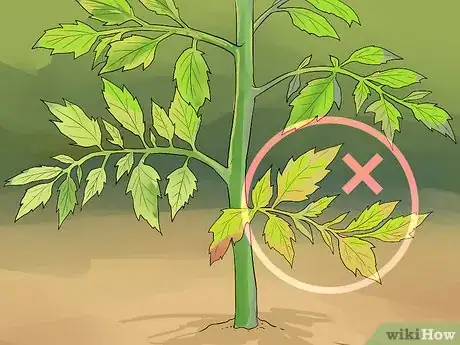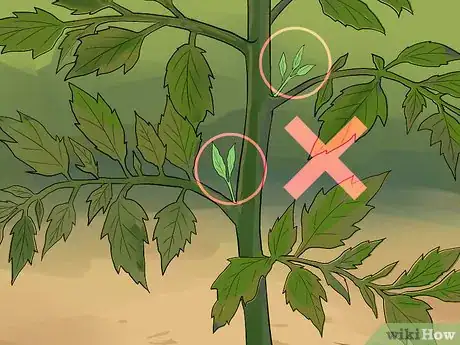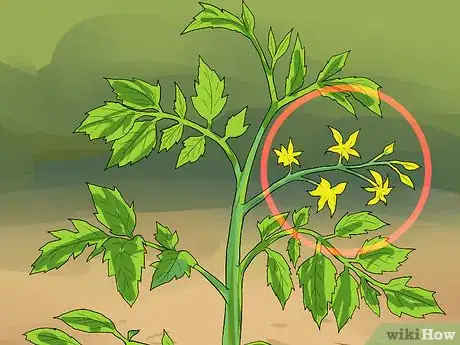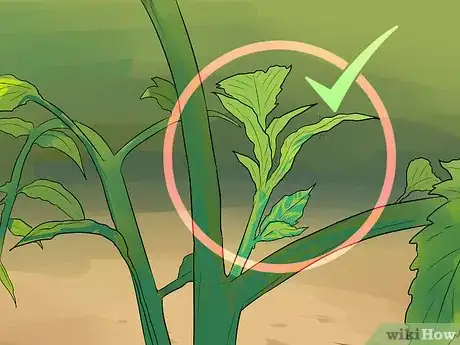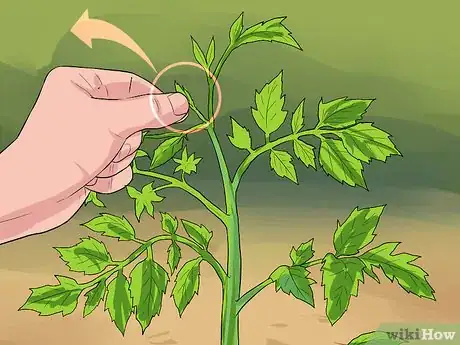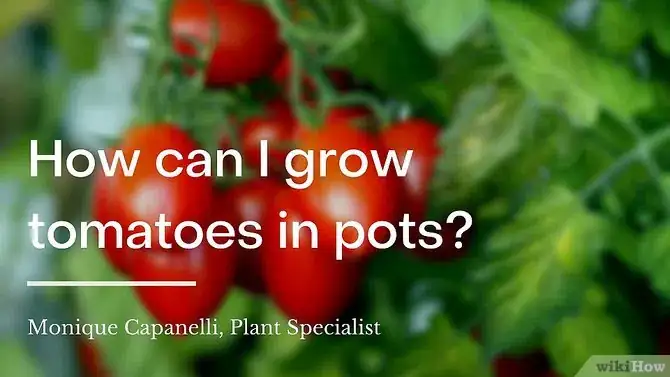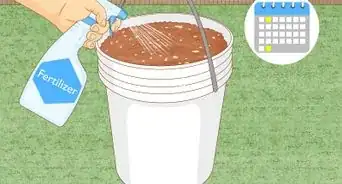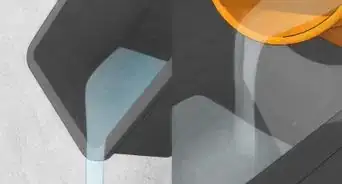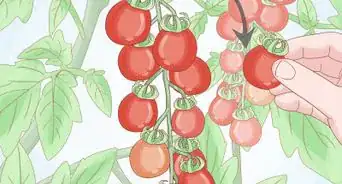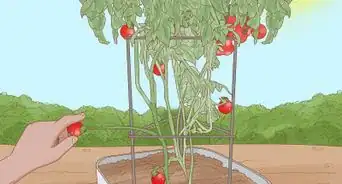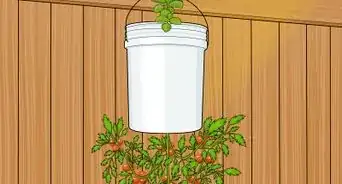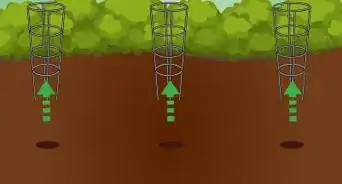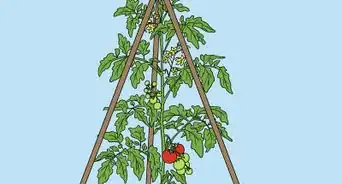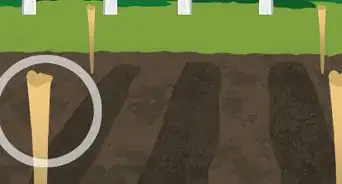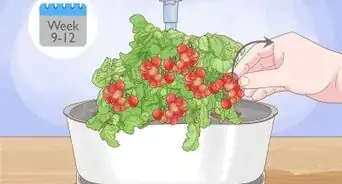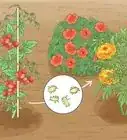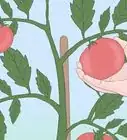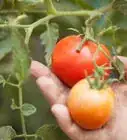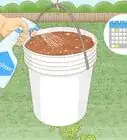This article was co-authored by Andrew Carberry, MPH. Andrew Carberry is a Food Systems Expert and the Senior Program Associate at the Wallace Centere at Winrock International in Little Rock, Arkansas. He has worked in food systems since 2008 and has experience working on farm-to-school projects, food safety programs, and working with local and state coalitions in Arkansas. He is a graduate of the College of William and Mary and holds a Masters degree in public health and nutrition from the University of Tennessee.
wikiHow marks an article as reader-approved once it receives enough positive feedback. This article received 51 testimonials and 96% of readers who voted found it helpful, earning it our reader-approved status.
This article has been viewed 2,206,945 times.
When growing tomatoes, the ultimate goal is to help the plant yield as much ripe fruit as possible. If you're growing indeterminate or "vining" varieties (Big Boy, Beef Master, most heirlooms, most cherry tomatoes), pruning your plants to remove unwanted shoots and leaves ensures that all the nutrients are going to the tomatoes. If you're growing a determinate variety (Biltmore, Heinz, Patio), too much pruning is counterproductive.
Steps
Deciding When to Prune Tomatoes
-
1Determine which variety you're growing. Before you make any cuts, figure out whether you're growing an indeterminate or determinate variety of tomato plant. Indeterminate varieties grow like vines, and they must be trained upright on poles and pruned in order to grow correctly.[1] Determinate varieties contain themselves before they grow into a bush, and they naturally direct their energy toward fruiting without needing as much intervention. Here are the common varieties of each:
- Indeterminate: Big Boy, Beef Master, Black Prince, German Queen, most cherry tomato varieties and most heirloom varieties.
- Determinate:Ace 55, Amelia, Better Bush, Biltmore, Heatmaster, Heinz Classic, Mountain Pride and Patio.
-
2Check the plant for signs of yellowing. One way to know when it is time to start pruning is to wait for the stems and leaves below the first set of flowers to turn yellow. When you notice this color change, you can start pruning.Advertisement
-
3Check for suckers. Look for the tiny new branches sprouting in the spot where a branch meets the stem on an indeterminate plant. These are called "suckers" and they're what you want to remove. Suckers left to grow will take energy from the rest of the plant and cause the plant to bear more fruits, but can cause the tomatoes to be smaller. This isn't always a bad thing, but strategically removing suckers will help your plant bear large fruit all season long.
-
4Look for flowers. It is a good idea to start pruning your tomato plants early, as soon as there are flowers on the plants. At this point, the plants should be between 12 and 18 inches.[2]
Using Proper Pruning Techniques
-
1Remove all suckers and their leaves below the first flower cluster. Do this no matter what kind of tomato plant you have. This keeps the plant strong by helping it grow a sturdy central stem. [3] This should ensure that the majority of the nutrients are sent to the fruits, instead of being wasted on the unwanted growing tips.
- To remove a sucker, grab a growing tip by the base between the thumb and forefinger and bend it back and forth until it snaps cleanly.
- This should ideally be done when the shoot is young, supple, and about 3 inches (7.6 cm) long. The small wound will heal quickly. This is called "simple pruning".[4]
- As for stems and leaves, not the suckers, growing below the first flower cluster: If you live in a warmer zone such as Zone 9, you should leave them on until they turn yellow. They are important for helping to shade the ground until the plant matures. On the other hand, if your plant is in a humid environment (such as a greenhouse), remove everything below the first flower cluster to improve ventilation. Humidity can make it easier for sicknesses to flourish, and it also causes the wounds that are created while pruning to dry up more slowly making the plant longer vulnerable. By improving ventilation, you're helping to protect the plant.
-
2Leave the thicker shoots. Thicker suckers should not be snapped off, since this could damage the whole plant. If it's thicker than a pencil, use the "Missouri pruning" method and pinch out just the tip of the sucker, leaving one or two leaves behind for photosynthesis and to protect developing fruit from sun scald. The drawback is that suckers will develop from the stem that you leave behind, which will require additional pruning. This technique is better when you're dealing with large suckers; if the wound becomes diseased, it will be further away from the main stem. This method also leaves a few inches on the sucker to reduce the shock to the plant.
- Prune suckers all summer long to keep the plant healthy. They grow quickly, so you may need to prune once or twice a week.[5]
-
3Pinch off all but four or five fruit bearing trusses for indeterminate varieties. These are the branches that grow from the main stem above the first flower cluster. Four or five will produce large, healthy fruit, but any more than that and the fruit will be small and scant. Choose four or five sturdy trusses to keep, then pinch out any additional side shoots, leaving the plant's top shoot intact, known as the terminal shoot.
- Make sure the vine-like plants are tied to supports after flowering occurs. Otherwise, the vine will grow along the ground and won't produce healthy tomatoes.
- Determinate plants already have a predetermined number of stems that will naturally grow, so there's no need to do any pruning above the flower cluster. If you prune above the flower cluster, you'll be removing fruit-bearing branches without helping the plant.
-
4Remove yellow leaves. Yellow leaves are leaves that use up more sugar than they produce. As the plant begins to mature, the lower leaves will naturally begin to yellow and wilt. This is perfectly normal, so pull these from the plant when they appear. It will keep the plant fresh and help ward off disease.
-
5Top the plant. To get the best out of the last growth of the season, it is necessary to "top" the plant. About a month before the first expected frost, or when the plant hits the roof of your greenhouse, remove the plant's terminal shoot.[6] At this point in the season, the tomatoes currently growing will have a limited time to reach maturity, so all nutrients must be directed straight to the fruit.
Expert Q&A
Did you know you can get premium answers for this article?
Unlock premium answers by supporting wikiHow
-
QuestionHow do you successfully grow tomatoes in pots?
 Monique CapanelliMonique Capanelli is a Plant Specialist and the Owner and Designer for Articulture Designs, an innovative design firm and boutique in Austin, Texas. With over 15 years of experience, Monique specializes in interior botanical design, living walls, event decor, and sustainable landscape design. She attended the University of Texas at Austin. Monique is a Certified Permaculture Designer. She provides plant and botanical design experiences, from small gifts to entire transformations, to shoppers as well as commercial clients including Whole Foods Market and The Four Seasons.
Monique CapanelliMonique Capanelli is a Plant Specialist and the Owner and Designer for Articulture Designs, an innovative design firm and boutique in Austin, Texas. With over 15 years of experience, Monique specializes in interior botanical design, living walls, event decor, and sustainable landscape design. She attended the University of Texas at Austin. Monique is a Certified Permaculture Designer. She provides plant and botanical design experiences, from small gifts to entire transformations, to shoppers as well as commercial clients including Whole Foods Market and The Four Seasons.
Plant Specialist
-
QuestionWhen should I start pruning?
 Andrew Carberry, MPHAndrew Carberry is a Food Systems Expert and the Senior Program Associate at the Wallace Centere at Winrock International in Little Rock, Arkansas. He has worked in food systems since 2008 and has experience working on farm-to-school projects, food safety programs, and working with local and state coalitions in Arkansas. He is a graduate of the College of William and Mary and holds a Masters degree in public health and nutrition from the University of Tennessee.
Andrew Carberry, MPHAndrew Carberry is a Food Systems Expert and the Senior Program Associate at the Wallace Centere at Winrock International in Little Rock, Arkansas. He has worked in food systems since 2008 and has experience working on farm-to-school projects, food safety programs, and working with local and state coalitions in Arkansas. He is a graduate of the College of William and Mary and holds a Masters degree in public health and nutrition from the University of Tennessee.
Food Systems Expert
-
QuestionShould my tomato plants be trimmed if they are brown and have dead leaves?
 Andrew Carberry, MPHAndrew Carberry is a Food Systems Expert and the Senior Program Associate at the Wallace Centere at Winrock International in Little Rock, Arkansas. He has worked in food systems since 2008 and has experience working on farm-to-school projects, food safety programs, and working with local and state coalitions in Arkansas. He is a graduate of the College of William and Mary and holds a Masters degree in public health and nutrition from the University of Tennessee.
Andrew Carberry, MPHAndrew Carberry is a Food Systems Expert and the Senior Program Associate at the Wallace Centere at Winrock International in Little Rock, Arkansas. He has worked in food systems since 2008 and has experience working on farm-to-school projects, food safety programs, and working with local and state coalitions in Arkansas. He is a graduate of the College of William and Mary and holds a Masters degree in public health and nutrition from the University of Tennessee.
Food Systems Expert
Warnings
- If you smoke, wash your hands thoroughly with soap and water before handling tomato plants. Tobacco smokers can easily infect tomato plants with "Mosaic Virus."⧼thumbs_response⧽
- To avoid infecting your tomato plants, always prefer fingers over blades for removing shoots (the resulting wound can be easily infected). However, for older, tougher shoots, you may have to resort to using a blade; if so, sterilize your cutting implement thoroughly for each use.⧼thumbs_response⧽
Things You'll Need
- Growing tomatoes
- Clean hands
- Sterilised cutting implement if using (hands preferred)
References
- ↑ https://gardeningsolutions.ifas.ufl.edu/plants/edibles/vegetables/cherry-tomatoes.html
- ↑ http://www.harvesttotable.com/2009/04/how_to_prune_a_tomato/
- ↑ http://www.taunton.com/finegardening/how-to/articles/pruning-tomatoes.aspx
- ↑ https://www.ag.ndsu.edu/yardandgardenreport/2019-07-09/how-to-prune-tomatoes
- ↑ http://www.taunton.com/finegardening/how-to/articles/pruning-tomatoes.aspx
- ↑ https://extension.unh.edu/resource/pruning-tomato-plants-fact-sheet
- ↑ http://faq.gardenweb.com/faq/lists/tomato/2000082337022708.html
About This Article
You only need to worry about pruning your tomato plant if it’s an indeterminate variety, meaning it continues to grow and produce fruit until it’s killed by frost. If your tomato plant is a determinate variety, meaning it has a shorter, predetermined lifecycle, there’s no need to prune it. If you’re growing an indeterminate variety, remove any flowers from the plant until it’s between 12 and 18 inches (30 and 45 cm) tall, which will send more energy to the roots. You should also pinch off any suckers that grow beneath the first flower cluster on the plant. Suckers are small shoots that grow where the leaf stems meet the main stem on the plant. Removing the suckers will direct more energy to the fruit. If the suckers are too thick to pinch off, use clean pruning shears to snip them off instead. Avoid pruning suckers above the first flower cluster since they will eventually flower and produce fruit. To learn other ways you can tell if your tomato plants are ready to be pruned, keep reading!

